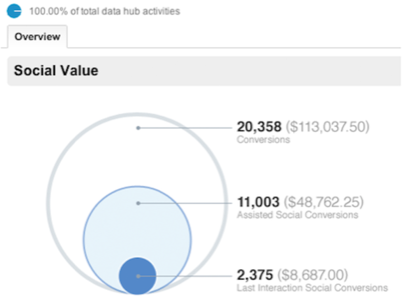Don’t believe the next social media expert who tells you “social media is intangible” when it comes to building your brand. Sure, it’s difficult to calculate a precise return on investment for social media marketing efforts: Just ask General Motors, which pulled $10 million in Facebook advertising last month because it couldn’t track measurable results. But social media reach is more measurable than some people would have you believe.

“Obviously this is a very new space so there isn’t one established way to think about it,” said Linus Chou of Google Analytics in a presentation at BlogWorld & New Media Expo in New York City this week.
The impact of social media is harder to measure than, say, the effectiveness of banner ads, because social media are often used to build brand loyalty. A person may see an ad or promoted social media message but choose not to click through, then search for the product later, and finally make a purchase on a third, fourth or fifth visit to the company’s website. While social media didn’t have a direct hand in the click-through and sale, it did have a hand in how the brand made a conversion.

Too many brands – GM included – rely on likes (which can be artificially inflated) and direct click-throughs (which don’t always result in sales). And while the industry is making strides to help brands better measure what they get for their social media buck, there is still a ways to go, Chou said. Social marketing by brands “is just terrible right now,” he observed. “I can’t tell you exactly what it should be, but I can tell you it sucks right now. People just shout.”
Social Value is Tangible

Even though analytics can’t measure the brand- and loyalty-building value of social media campaigns, brands should be wary of marketing experts who tell them social media is “intangible,” Chou said. He calls that a lie.
“When you pay for a click, you can measure exactly what that click gets you,” Chou said. “With social, maybe they don’t convert there, but they convert somewhere down the line.”
Right now, marketers can’t easily measure a follower who doesn’t click on links or interact directly with a brand’s Facebook page or Twitter feed. That will change as social media tracking gets better. But for now, Chou said, marketers should focus on tracking the numbers they can quantify.
“Social is, in fact, measurable, and you need to understand that’s what you’re trying to do,” he said. “If you can measure it, you can say you did a good job. If you’re not measuring it, you’re just shooting in the air.”
Chou calls the number of followers a “vanity metric” that doesn’t say much about how effective a social campaign is. Marketers can, after all, pay for followers. For now, the best way to measure the effectiveness of a social media campaign is to figure out which messages posted to Facebook, Twitter and other sites result in the highest levels of interaction.
It is also possible to track where users are coming from. Google Analytics, for example, tracks 400 top social networks, allowing marketers to see where they should focus their attention. They can also identify followers who are influencers and target them.
“Find something you can measure, and sprint in that direction,” Chou said. “Just cling to something… if you can’t measure what you’re trying to achieve, how are you going to improve?”
Content is King
What the current state of analytics can do is help track which messages are working and which are not. A message that does not work is more dangerous than a message that doesn’t spur action: It can cause followers to lose interest.
“Content turns into spam at some point,” Chou said. “At some point, if I’m posting a ton of crap to any network, someone might choose to unfollow me.”
Chou outlined four ways social media managers could measure the effectiveness of their posts:
Virality: Good content gets shared. A viral video is cheap to make and can bring your message to new eyeballs. “Other mediums don’t have that,” Chou said.
Engagement: The 80/20 rule applies to social media, Chou said: 20% of the people generate 80% of the sharable content. “The more granular you can get… the better understanding you have of what’s going on,” he said. “Some of that we can get to today: You can understand who are the people you want to be interacting with first.”
Advocacy: Social media lets brands get endorsements from everyday people, so brands should pay attention to posts that get retweeted. “If my friend posts something, it means more to me than if some random brand posts something,” he said.
Retention: Every message needs to be measured for its retention value. Every new follower is an additional member of the audience for your next message.










